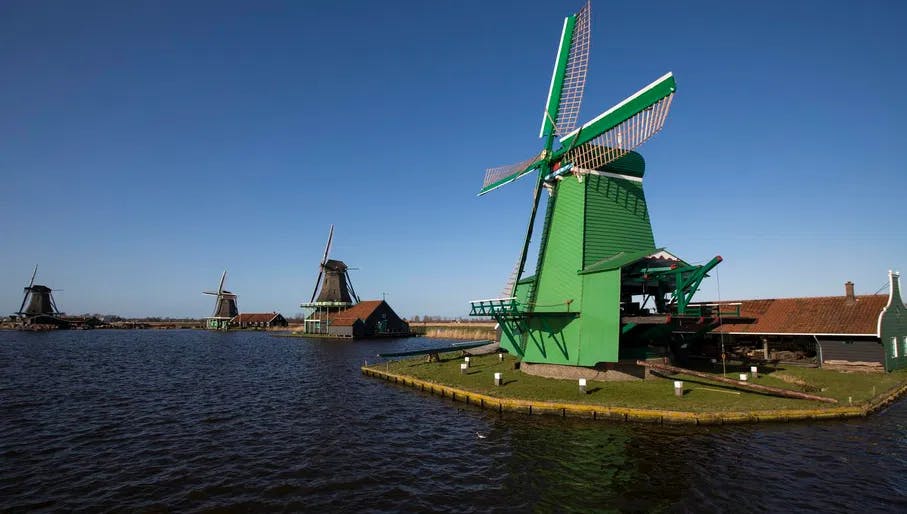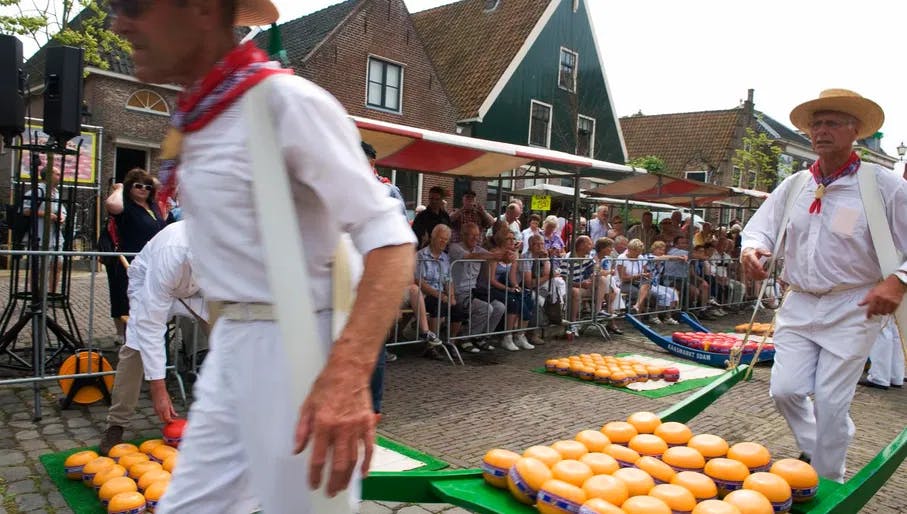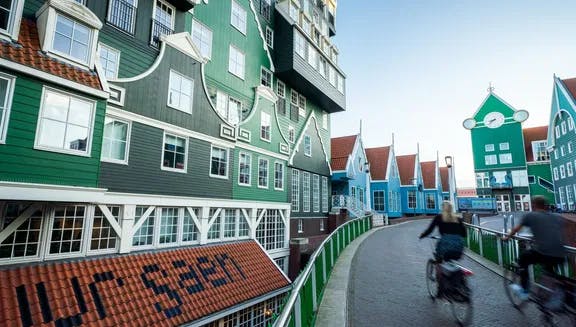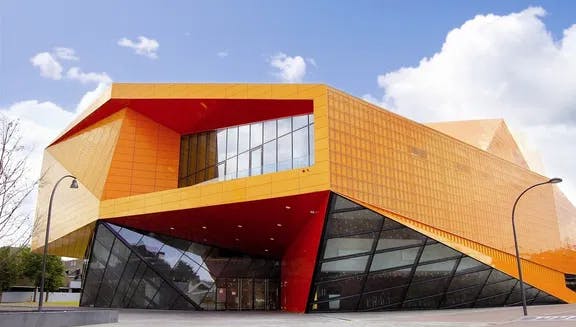
Art and culture in Old Holland
Zaans Museum and Verkade Experience

The Zaans Museum tells the story of daily life in the Zaan region over the centuries. The Zaan is one of the oldest industrial areas in Europe, and wind and water played an essential role in its success. In 1871, the world-famous French painter Claude Monet visited the Zaan region and became so inspired that he made no fewer than 25 paintings here. In the Zaans Museum, you can see De Vooraan and the Westerhem and an interactive presentation with all his Zaanse works. At the heart of the Zaans Museum, you will find also the Verkade Experience. A treat for young and old alike, the Verkade Experience transports you back to the chocolate-and-biscuit factory of the early 20th century, where the original machines are still churning away.
Hembrugterrein

Once a hub for the production of ammunition and weaponry, Zaandam's Hembrugterrein has now transformed into a cultural centre housing restaurants such as Lab-44, art and design ateliers, museums and creative venues. Here, you’ll find the light-drenched Museum of Humanity, featuring dozens of thought-provoking portraits of people from all over the world to pose questions about what it means to be human. Also check out Bind, a cultural clubhouse and cafe, where the (largely Dutch) programme for storytelling, community dinners and barbecues is also open for coffee and vegetarian snacks.
MonetAtelier

‘Zaandam is quite remarkable,’ wrote Claude Monet, ‘and there is enough to paint for a lifetime.’ Indeed, the region seems to have inspired him, and during his short stay in 1871, he created 25 paintings. Replicas of Monet’s 25 Zaandam paintings can be seen in the MonetAtelier along the River Zaan in the centre of Zaandam. The Atelier is located in the rebuilt ‘Luchthuis aan de Zaan’, a house from one of Monet’s paintings. The Zaans Museum also owns a real Monet and is definitely worth a visit.
Zaanse Schans

Located just north of Amsterdam, the Zaanse Schans open-air museum offers a perfectly preserved glimpse into the Netherlands' industrial past with its traditional houses, windmills, warehouses and workshops. In its 18th and 19th century heyday, the Zaan region was an important industrial area dotted by hundreds of windmills producing linseed oil, paint, snuff, mustard, paper and other products. Many of the Zaanse Schans' characteristic village houses are now museums, gift shops or workshops, while others are still used as private residences. Some of the Zaanse Schans' remaining windmills are also open to the public.
Honig Breethuis Museum

Across the water from the Zaanse Schans, you will find the protected village of Gortershoek with its beautiful 17th- and 18th-century merchant houses. To get there, cross the bridge over the River Zaan, or take the pedestrian ferry departing from the Zaanse Schans (May-Sept, €1). One of the former Gortershoek merchant houses is now the Honig Breethuis Museum which houses an exhibition on the history of Zaanse paper, original hand-painted wallpaper from the 18th century, beautiful porcelain and much more.
Windmill Museum

The charming Windmill Museum, only a 15-minute walk from Zaanse Schans, forms an excellent beginning or end point of a visit to the area. From the 17th to 19th centuries, the Zaanstreek flourished as one of Europe's first and most important industrial areas. Here you can see countless paintings, models and original instruments that will transport visitors back in time.
Czar Peter House

During the 1600s, wood was sawn, and sails and ropes were woven in the windmills of the Zaan region. The strategic location on the water and close to Amsterdam saw the area flourish during the 17th century. The 11-kilometre waterfront of the River Zaan connects some 75 vintage industrial buildings, including windmills and the vast Industrial Wall at Wormer. It makes for a surprisingly beautiful view of the river. At the start of the River Zaan is the Czar Peter House – one of the oldest wooden houses in the Netherlands – where Peter the Great spent a week learning the craft of shipbuilding in 1697.
De Kaaswaag

In the 14th and 15th centuries, the fortress town of Edam was one of the country’s most important commercial centres, and it continues to be known worldwide for its cheese. Until 1922, farmers from the surrounding area sailed to Edam’s cheese market, where their produce was weighed and sold. You can see these old practices for yourself when the cheese market is revived every Wednesday in July and August (10:30-12:30). Alternatively, De Kaaswaag (Cheese Weighhouse) in Edam invites you to explore the cheesemaking traditions of Edam, the cheese capital of the Netherlands located north of Amsterdam. Tasting is allowed!
Marker Museum

The unique village of Marken is like an outdoor museum in itself, as residents have preserved many of the island’s traditions. Anthropologists flocked to the village in the 19th and 20th centuries to study what was considered a relic of traditional culture. While you may not encounter too many people still dressed in attire that was all the rage in similar fishing communities back in the 19th century, you will find many of its historic homesteads still standing. While you’re there, visit the Marker Museum, which offers a fascinating look into the area's heritage and distinctive way of life.
Museum Zaanse Tijd

Timekeeping is at the heart of science and technology, and the Museum Zaanse Tijd pays homage to it with its unique focus on the craft of the clockmaker. Travel back in time and marvel at animated clocks depicting themes typical of the historical Zaan region, such as spinning windmills or whaling scenes. Exhibits include many intricate timepieces, from an Egyptian water clock to 16th-century turret clocks, the earliest pendulum clocks and an extensive collection of pocket watches.
Volendams Museum

The Volendams Museum, located in the town of Volendam, is definitely one of the Netherlands' most unconventional museums. Here, you can glimpse some of the more unique elements of early Dutch life in the region, with an exciting assortment of art, life-size dioramas and fascinating artefacts. Its collection includes works by celebrated painters like Henricus Rol and Edwin Austrin Abbey and more unusual items like 19th-century fishing vessels and antique uniforms. One of the museum's cornerstones is a series of large mosaics which comprises over 11 million cigar bands.
Related articles

Industrial Heritage Cycleseeing Route: windmills and shipyards

Family and kids in Old Holland

About Old Holland

6 hours in Old Holland: traditional artisans

12 hours in Old Holland: polder landscapes and heritage

Where to stay in Old Holland

Things to do in Old Holland

Getting to Old Holland

Art and culture in New Land
